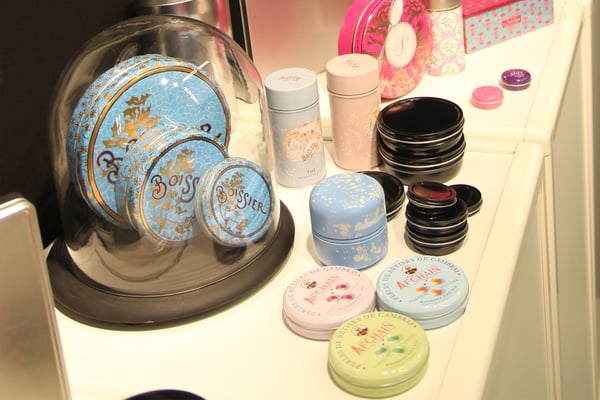Consumer studies on the need for touch (NFT) point toward fascinating opportunities for metal packaging designers to learn new ways to understand shopping behavior. The search and purchasing stages are the key areas of focus that can help a brand gain an edge on understanding of consumer decision-making patterns.
Here's a look at what research says about NFT that may lead to innovations in metal packaging.
Consumer Touch Studies
Two key areas of focus in recent NFT studies are type of touch (autotelic vs. instrumental) and types of shopping tasks, such as goal-oriented or experiential-oriented. Autotelic touch is associated with creativity and purpose while instrumental touch covers physical channels and online purchasing at the lowest prices. Both autotelic and instrumental NFT dimensions both target goal-driven and experiential customers. Instrumental NFT, though, overshadows the autotelic dimension. A RetailDive study published in 2017 found that 55 percent of respondents said they still go to brick-and-mortar stores to see, touch and feel products to help make purchasing decisions.
Age plays a role in consumer behavior in the sense that 70 percent of shoppers over age 65 visit stores specifically to see, touch and feel merchandise before buying. These older consumers broadly prefer the traditonal methods of retail. On the other hand, younger buyers are more into searching for products online as a more efficient shopping process. Buying online doesn't require burning fossil fuels or spending extra money on transportation.
Another finding from the RetailDive consumer study on touch is that product interaction in crucial for the shoppers who need to see, touch and feel products in retail stores. Physical retail chains, food package designers and manufacturers should all be aware how much certain market segments, particularly seniors, depend on touching before buying.

Aluminum vs Tinplate
The question as to what type of material works best with human touch depends on the branding and type of product. Using aluminum often works well for lighter products, while tinplate provides more stability for heavier items.
Both aluminum and tinplate are widely used metals in packaging for multiple reasons including durability, longevity and flexibility that the material can be easily cut into various shapes. That fact alone makes these metals excellent choices for customized marketing solutions, as shapes and sizes play a roles as visual stimuli that influence perception. Both metals convey strength, which is what a consumer may envision when touching a soda can or a canned food item.
One of the reasons why when a consumer touches aluminum or tinplate they perceive a sense of strength is that these metals are temperature resistant. Consumers can sense when touching these metals that they provide excellent barriers to protecting food. This concept is particularly evident when a shopper touches a refrigerated can of any type of drink. If they are shopping for a cold drink, touching the aluminum can provides confirmation the drink feels cold.
When Touch Isn't Possible
Since online consumers are physically denied the opportunity to touch a product before making a purchase, it presents numerous sales challenges. A study at Complutense University showed that physical channels outperform internet channels when one adds up the effects of multichannel shopping.
The three main reasons for the widespread growth of online buying include convenience, competitive pricing and prioritizing trust in online reviews. One of the questions that arises from this data is: how can e-commerce sites improve how they at least display products online? Perhaps new developments in 3D imaging and virtual technology will provide answers. In the meantime, physical establishments should take advantage of the advantages they still have with the advantages of seeing, touching and feeling a package.
Consumer Decisions and Satisfaction
.jpg?width=300&name=DSC_1970%20(1).jpg) Touch influences the re-purchase decision and customer satisfaction. Metal packaging designers should always be searching for new ways to evoke emotions through touch, which generates information. The mind quickly processes touch information into emotion, judgment and behavioral response.
Touch influences the re-purchase decision and customer satisfaction. Metal packaging designers should always be searching for new ways to evoke emotions through touch, which generates information. The mind quickly processes touch information into emotion, judgment and behavioral response.
Many older consumers become repeat customers due to being allowed to use touch as a confirmation in the decision-making process.
Every material has a certain feel that triggers various perceptions based on individual experiences. Some of the multiple variables that can contribute to judgments based on touch include shape, texture, hardness, weight and temperature. Another dynamic that shapes consumer perceptions when touching the package surface involves utilitarian vs. hedonic values. Utilitarian values equate to the degree of purchasing efficiency, while hedonic values are more pleasure-oriented.
The search channel and the purchase channel each represent important journeys for the consumer that shape behavior. The more touch plays a role in the purchasing decision, the greater the odds of generating an emotion associated with the touching sensation. Several studies have shown that higher levels of NFT can be achieved when focus is on utilitarian/instrumental dimension, which outperforms its hedonic/autotelic dimension.
Conclusion
Metal works as a reliable packaging material for multiple reasons with aluminum and tinplate serving as leading examples. Both metals provide durability, longevity and recyclability, all of which contribute to a perception of strength, particularly when touch is applied. Research shows that older age groups lean toward a higher need for touch when making purchasing decisions, while younger age groups are more comfortable with online shopping.
Reference
- Read more in our series on the Need For Touch (2018 - today)
- The Influence of Need for Touch in Multichannel Purchasing Behaviour: An approach based on its instrumental and autotelic dimensions and consumer´s shopping task (2016), by Roberto Manzano, Magdalena Ferrán, Diana Gavilan, Maria Avello , Carmen Abril
- Consumer Need for Touch and Multichannel Purchasing Behaviour (2013), by Roberto Manzano, Magdalena Ferrán, Diana Gavilan,






